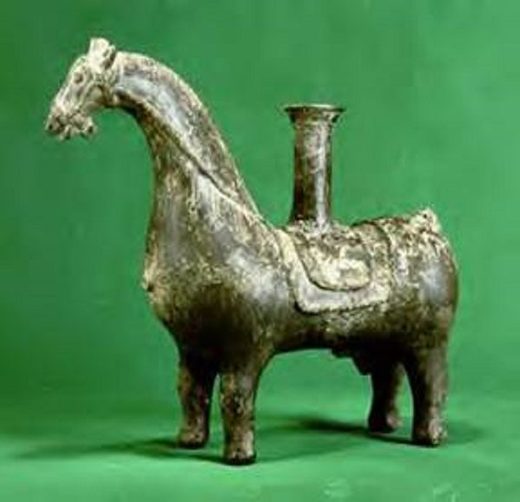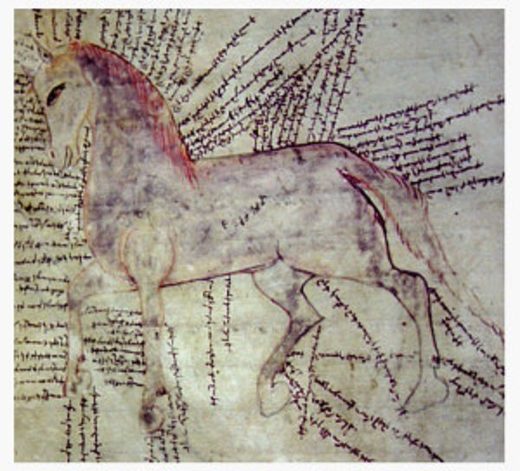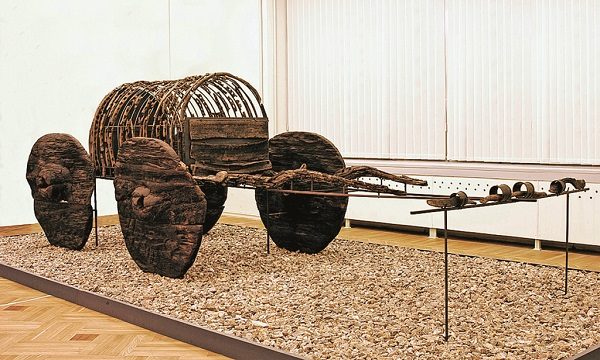Horse breading, the domestication of the horses and the development of the chariot in Armenia dates back to the time immemorial. In fact, the Armenian Highlands were renowned for horse breeding and horsemanship throughout ancient times. Murals of the Iron Age (Armenian) kingdom of Ararat attest to the richness of this practice. Traditionally Armenians consider themselves as descended from the biblical Torgom (Togarmah), where the Bible refers to the House of Togarmah, a land known for its horses (Ez. 27:14). For this reason the ancient Persians would collect Armenian horses as part of taxation for their armies and the royal guard (Strabo, 20 B.C.). Equally revered was the Armenian cavalry of the ancient times.

Armenian horsemaster bringing tribute to Darius I of Persia, Behistun Inscription (515 BC.)
V. Chapot wrote: "What they say about Armenia bewilders us. How could this mountain people develop such a cavalry that was able to measure itself against the horsemen of the Medes? One thing which is certain is the fact that Armenia ...was a source of excellent well bred horses. The people in this country had discovered that horses were not just an economic asset, but could also be used for military purposes."
In his chronology (Timeline of the Development of the Horse, 2007) Beverley Davis describes the domestication of the horse in Armenia as follows:
3000 B.C.- Petroglyphs found in Armenia (one of the possible sites for the Indo-European homeland)
show the oldest pictures of men driving chariots, wagons, and plows, with horses doing the pulling.2000 B.C.- Primitive wagons dating from this time have been found in excellent condition in Armenia. These are the oldest known wagons in the world.
1074 B.C.- Tiglath Pilser I becomes the first great king of the Assyrian Empire. The need for horses drives him into the lands of the Indo-Iranian horse peoples and Armenia.

Bronze work: ancient Armenian horse head (7thc. BC.)
- Marc Antony takes a 10,000-horse cavalry, most of the animals coming from Spain, to Syria in his war against Parthia. He loses the war and ravages Armenia, returning to Egypt with Armenia's king and the first large number of Nisean horses in the Roman Empire. Augustus Caesar ends up with them after defeating Antony.
111-114 A.D.- Armenia, the breeding ground for the Nisean horse, is annexed by Rome.
396 A.D.- The Huns raid Armenia, looking for horses and riches.
Recent archaeological discoveries made in Armenia push these dates even further back. Unique discoveries revealed as a result of excavations at Shengavit and the village of Nor Naver, Armenia (4000-3000 B.C.) Director of the Scientific and Research Institute of Historical and Cultural Heritage Hakob Simonyan said: "... the amount of revealed horse bones at the territory has exceeded all expectations of the researchers." With respect to this, German paleozoologist Hans Peter Wertman stated that he has not observed such a quantity of horses in the entire Ancient East.
Furthermore these finds provide evidence that Armenians were among the earliest nations engaged in horse breeding for military purposes.

Horse effigy from ancient Armenia (Iron age kingdom of Ararat)
Archeologists have managed to excavate seven tombs with bones and depictions of horses, proving their intensive cultivation.
Archeological finds are dated at 25-20 centuries B.C."Evidence is found, that Armenians is among first nations engaged in horse breeding and particularly thanks to ancient Armenians several breeds of horses were created," Hakob Simonyan said.

Page from a medieval Armenian horse manual (13th century)
During the middle ages Armenians continued this tradition of horse mastery and with the invention of the
Armenian alphabet produced stunning scientific writings, of which only a handful survived to this day. This oldest known manual about Armenian horse medicine consists of 184 handwritten pages. It was written in the Armenian kingdom of Cilicia between 1295 and 1298.The first chapter explains the creation of the horse. The following chapters describe the good and bad characteristics of horses, breeding, the different races known at that time, breaking in and riding, horse care and defects. And the last chapters deal with different types of pain as well as illnesses, symptoms and treatments.
This Armenian manual about horse medicine from the 13th century has been translated into German for the first time in 2005. The compendium is Armenia's oldest preserved veterinary medical work and offers an overall view of expert knowledge about horses during the late 13th century in the Near East.

Found near Lake Sevan, Armenia Ancient wheel barrel. 2500 BCE
Sources:
http://www.arak29.am/PDF_PPT/origins_2004.pdf
http://www.panarmenian.net/news/eng/?nid=32949
http://www.fwf.ac.at/en/public_relations/press/horses.html
http://www.panarmenian.net/eng/society/news/50844
http://www.sino-platonic.org/complete/spp177_horses.html
V. Chapot, La frontière de l'Euphrate de Pompée à la Conquète arabe, 1907, Paris
Reader Comments
to our Newsletter